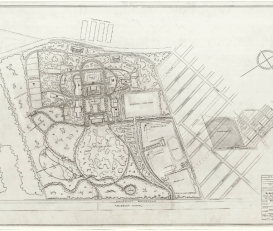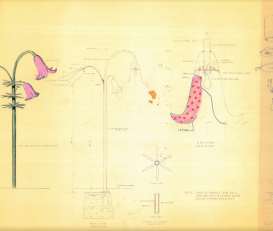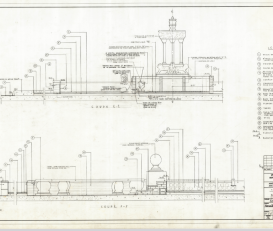
In Montreal, the late 1950s marked the heady onset of an era of large neighborhood sports parks, playgrounds and arenas. But for a youthful Maurice Hamel, together with a growing team of Quebecois landscape architects working for the city, the transformation of Montreal’s parks had long since begun.
Hamel had already enjoyed the early resurgence of the newly formed Montreal Parks Board in 1955. Two years earlier, he had begun to work with veteran landscape architects like Fellow Maurice Howitt, who had returned to Canada after a long career in New York, just as an ambitious Montreal was beginning to embrace the profession.
In 1953, working with Howitt’s design for Angrignon Park, Hamel had created a detailed drawing for a mini-zoo and picnic area. And some two years later, with the arrival of the department’s first Director of LA, Fellow Warner Goshorn, Hamel continued to produce drawings for the exuberant new “marvels” coming to town. In the city’s beloved Lafontaine Park, for example, the team constructed a Garden of Marvels (Jardin des Merveilles) and a Children’s Zoo, graced by totems, a monkey house, a party patio and playful fancies like monkey lights (drawn by Hamel on yellow paper).
In these early years, recounts Hamel’s future colleague, Fellow Jean Landry, city parks were valued primarily as essential leisure areas for Montrealers. Each park required playing fields, adult gaming courts, an area for tots, and playgrounds for older children. “With a total annual budget of around two million dollars, Lafontaine, Chartrand, Hamel and Co. implemented softball, baseball, football and hockey in new parks that followed the expansion of neighborhoods to the north, east and west of Montreal island,” wrote Landry, launching some 35 projects each year.
As the pace intensified, Hamel and his colleagues helped lead the push to found the Association des architectes paysagistes du Québec (1965).
City of Montreal Parks, notes historian Ron Williams, was destined to become the largest landscape architectural office in Canada in the game-changing years when the City prepared for Expo ’67 (Terre des Hommes), the Montreal Olympics (1976), and the Floralies (1980).
Hamel drew, then designed, then managed hundreds of works. Over the years his designs increasingly included complicated water management. More than two decades after his early drawings of Angrignon Park in 1953, he again prepared plans for the park’s renewal with a Jardin d’ecoliers, including grading, planting and drainage.
As a veteran of the department, Hamel was an inspiration. “I had the honour of working alongside him in the early 80s before he retired,” remembers Fellow Wendy Graham. “Maurice was a skilled and knowledgeable designer who mastered the art and science of drainage plans. He was funny and had a dry sense of humour that he developed and refined over his thirty-plus years as landscape architect for the city of Montreal Parks Service. He was a natural teacher and a generous man.”
Sources
De Parcs à Espaces Verts: Plus de 25 ans d’architecture de paysage à la Ville de Montréal, by Jean Landry. Courtesy Archives of City of Montreal Parks/ Ville de Montréal, Service des Grands Parcs, du Mont Royal et des Sports.
All plans and drawings, Plans Courtesy Ville de Montreal Archives
- Staff of City of Montreal Parks: Photo Courtesy Wendy Graham
- 1953, Development plan for Angrignon Parc zoo and picnic area, (Design Maurice Howitt; Drawing Maurice Hamel)
- Lafontaine Park, 1957-59. (Projects designed by Warner Goshorn; drawings Maurice Hamel) 2A Children’s Zoo, Ornamental Safety Light: Monkey Model; 2B Proposed location of Monkey House; 2C Party Patio. possibly 2D Ornamental Safety Light: Flower Model; 2E Totem Pole
- Lafontaine Park. Jardin des Merveilles, 1962. Small elephant enclosure. (Design by Goshorn, Drawing by Hamel)
- Terrain de jeux, Ile Ste-Hélène, 1966. Landscaping isometric. (Prepared by Hamel; Verified by Goshorn)
- (2 drawings) Terre des Hommes, 1968. Biosphére, Plateforme D, Coupes. (Design M. Hamel; Verified Goshorn.)
- Parc Angrignon, Jardin d’ecoliers. 1976. Planting, grading, drainage and conveyance of water. (By M. Hamel)
- Terre des Hommes, 1980. Floralies Internationales. Aire d’Accueil. (Design Chartrand; Team leader M. Hamel)
- Parc Jarry, 1984. Design preliminary study. (Designer + project landscape architect, M. Hamel)













